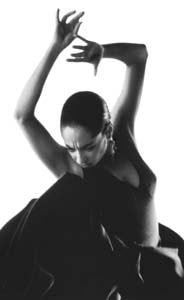![[Metroactive Movies]](/movies/gifs/movies468.gif)
![[Metroactive Movies]](/movies/gifs/movies468.gif)
[ Movies Index | Metro | Metroactive Central | Archives ]
The Pain From Spain
 Arms and the Woman: The dance itself is more important than the individual dancers in Carlos Saura's 'Flamenco.' Photo by Katrina Dickson
Carlos Saura's new film focuses on the passion and suffering of 'Flamenco' ASIDE FROM the uncredited man who directed a famous Bic pen commercial in the mid-1960s, Carlos Saura is the filmmaker who has done the most to promote the art of flamenco. Flamenco is an early--maybe the earliest--example of world music, with influences that cross Europe and Asia. Traces of Indian dance, Muslim singing and European melody can be found in flamenco, and its Spanish guitar stylings have permeated classical music and rock alike. Saura's most exciting flamenco film is El Amor brujo (1986), which displayed the art of flamenco music and dance through composer Manuel de Falla's ballet, an arrangement of some devastating Spanish folk tunes (which were also interpreted by Miles Davis on Sketches of Spain). A story of ensorcellment and passion from beyond the grave, El Amor brujo provided a text to enjoy along with the furious, passionate music and dance. Saura's latest, Flamenco, a performance showcase, is as handsome a film as you'd expect from master cinematographer Vittorio Storaro (The Conformist and Apocalypse Now). Like El Amor brujo, Flamenco is also stage-bound. It takes place in a wooden-floored rehearsal studio, decorated only with translucent scrims diffusing colored stage lighting. The tones are primarily lemon yellows and burnt oranges. Sometimes the backlighting turns the dancers into silhouettes against a white-out. Another of Saura and Storaro's tricks is to illuminate a circle of guitarists with a recessed orange-red lamp to mimic the effect of a campfire. Saura has stripped down his frame to include nothing but the dancers and singers--and the chairs they sit upon. No subtitles tell us who the performers are; aside from a title that gives the name of the song, ordinary English speakers will not know what they are singing about. (Presumably the lack of a text is to keep English speakers from being distracted.) The more than 100 artists presented are virtually anonymous, since they're not named. The musicians and dancers are all ages, starting with children, but the majority are aged. When the flamenco mood hits these elderly performers--the old disappointments and heartbreaks becoming fresh--they wave and clutch their hands, as if to grasp hopelessly at some last particles of fleeing love. It may be that dance unconnected to some thread of narrative is a bit hard for anyone who isn't a rabid fan to enjoy. Among the many needs the movies aren't fulfilling lately is the need for dance; crowds snatch gratefully at what they can get--as you could see from watching the delighted response to the first 10 minutes of Austin Powers. Still, Flamenco more than satisfies an ordinary interest in flamenco; a moderately curious viewer will be sated after about an hour.
Flamenco (Unrated; 100 min.), a documentary by Carlos Saura, photographed by Vittorio Storaro. [ Metro | Metroactive Central | Archives ]
| ||||||||||||||||||||||||||||||
Copyright © Metro Publishing Inc. Maintained by Boulevards New Media.